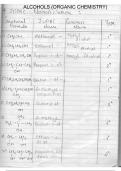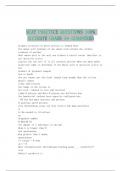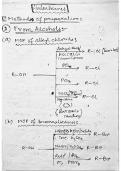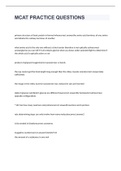Grignard Study guides, Revision notes & Summaries
Looking for the best study guides, study notes and summaries about Grignard? On this page you'll find 57 study documents about Grignard.
Page 4 out of 57 results
Sort by

-
Organic Chemistry 1 Chapters 12 and 13 (Final Chapters)
- Lecture notes • 9 pages • 2023
- Available in package deal
-
- £8.45
- + learn more
Chapters 12 and 13 wrap up the Organic Chemistry 1 class. We begin Chapter 12 to learn about alcohols and phenols. Students should already have extensive knowledge about alkanes, alkenes and alkynes. They will then learn how the IUPAC name for alcohols differs slightly. They will also learn about oxidation and reduction reactions and how to recognize one. Additionally, students will learn about Grignard reagents and how they contribute to oxidation and reduction reactions. It is also important f...

-
Organic Chemistry (Alcohols)
- Summary • 27 pages • 2024
- Available in package deal
-
- £8.05
- + learn more
Embark on a transformative journey through the fascinating world of alcohols with our meticulously curated class notes. Designed for students, educators, and professionals alike, these notes are your key to unlocking a deep understanding of the principles, reactions, and applications of this versatile class of organic compounds. Our class notes on alcohols offer a comprehensive exploration of every aspect: Foundations of Alcohols: Lay a solid groundwork by delving into the fundamental conc...

-
HELP TO DEAL WITH ORGANIC CHEMISTRY
- Interview • 24 pages • 2023
-
- £7.57
- + learn more
his chapter introduces students to the organic compounds known as aldehydes and ketones, which are characterized by the carbonyl functional group (C=O). Here's an overview of what is usually covered in this chapter: Introduction to Aldehydes and Ketones: Aldehydes and ketones are organic compounds with a carbonyl group, which consists of a carbon atom doubly bonded to an oxygen atom. In aldehydes, the carbonyl group is at the end of the carbon chain, while in ketones, it is found within ...

-
Organic Chemistry Reactions Summary: Nucleophilic addition and substitution
- Summary • 7 pages • 2022
-
- £2.21
- + learn more
organised, colour coded word document with small diagrams and descriptions of mechanisms in words. All reactions are tabulated showing reagents, products, and mechanism for each reaction Contents: Organic Chemistry Summary; Nucleophilic 1-2-addition at carbonyl groups; Nucleophilic addition to aldehydes and ketones; Nucleophilic substitution at carbonyl groups; Carboxylic acid derivatives; Reactions of acid anhydrides and acid chlorides; Chemistry of esters; Imines and enamines; Ide...

-
MCAT PRACTICE QUESTIONS 100% ACCURATE GRADE A+ GURANTEED
- Exam (elaborations) • 20 pages • 2023
-
- £10.99
- + learn more
primary structure of basic protein is formed when the amino acid terminus of one amino acid attacks the carboxy terminus of another what amino acid is the only one without a chiral center therefore is not optically active glycine you can tell if it all contains glycine when you know under polarized light to determine if the whole acid is optically active or not product of grignard reagent new cc bonds the eye cannot get the focal length long enough then the ciliary muscle cannot relax suf...

-
chem 210 exam 4 with 100% correct answers
- Exam (elaborations) • 5 pages • 2023
-
- £11.28
- + learn more
enantiomers are formed from __________ carbocation achiral __________ are formed from chiral carbocation enantiomers grignard reagents attack (most/least?) substituted epoxide? least grignard reagents are used for (carbanion/carbocation?) generation. carbanion we wat to use grignard reagents in (acidic/non-acidic?) conditions. non-acidic if acidic conditions, it will suffer proton transfer hyperconjugation is (de/stabilizing?) for carbanions. destabili...

-
Class notes of important concepts in Organic Chemistry
- Package deal • 6 items • 2023
-
- £16.51
- + learn more
This package contains 1. Methods of Preperation of Haloarenes 2. Methods of Preparation of Haloalkanes 3. Heating effect of Dicarboxylic acid 4. Reimar-Teimann Reaction 5. Oxidation and Reduction of Carbonyl Compounds and Alcohols 6. Grignard Reagent

-
MCAT PRACTICE QUESTIONS WITH CORRECT ANSWERS
- Exam (elaborations) • 28 pages • 2023
-
- £10.47
- + learn more
primary structure of basic protein is formed when the amino acid terminus of one amino acid attacks the carboxy terminus of another what amino acid is the only one without a chiral center therefore is not optically active glycine you can tell if it all contains glycine when you know under polarized light to determine if the whole acid is optically active or not product of grignard reagent new cc bonds the eye cannot get the focal length long enough then the ciliary muscle...

-
MCAT Practice Questions With 100% Correct Answers And Latest Test
- Exam (elaborations) • 20 pages • 2023
-
- £11.28
- + learn more
MCAT Practice Questions With 100% Correct Answers And Latest Tests Primary structure of basic protein is formed when the amino acid terminus of one amino acid attacks the carboxy terminus of another what amino acid is the only one without a chiral center therefore is not optically active glycine you can tell if it all contains glycine when you know under polarized light to determine if the whole acid is optically active or not product of grignard reagent new cc bonds the eye cannot get t...

-
Epiphany term organic chemistry summary
- Summary • 32 pages • 2023
- Available in package deal
-
- £4.49
- + learn more
A summary of all the mechanisms and content covered in organic chemistry for Durham university epiphany term in year 1. With each mechanism shown in detail and each step explained. Additionally, any important information also included, such as pKa values explained.

Did you know that on average a seller on Stuvia earns £76 per month selling revision notes? Hmm, hint, hint. Discover all about earning on Stuvia


